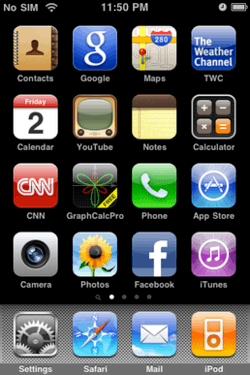iPhone OS 3
| A version of the iOS operating system | |
 | |
|
iPhone OS 3.1.3 running on an iPhone 3GS | |
| Developer | Apple Inc. |
|---|---|
| Source model | Closed, with open source components |
| Released to manufacturing | June 17, 2009 |
| Platforms | |
| Kernel type | Hybrid (XNU) |
| License | Proprietary EULA except for open-source components |
| Preceded by | iPhone OS 2 |
| Succeeded by | iOS 4 |
| Official website | iPhone OS 3 at the Wayback Machine (archived August 18, 2009) |
| Support status | |
| Unsupported | |
iPhone OS 3 is the third major release of the iOS mobile operating system developed by Apple Inc., being the successor to iPhone OS 2. It was announced on March 17, 2009, and was released on June 17, 2009. It was succeeded by iOS 4 on June 21, 2010; the new version dropped the "iPhone OS" naming convention.[1]
iPhone OS 3 added a system-wide "cut, copy, or paste" dialog bubble, allowing users to more easily move content. It also introduced Spotlight, a search indexing feature designed to help users locate specific information on their device, such as contacts, email messages or apps. The home screen was expanded to let users add up to 11 pages, showcasing a total of 180 apps. The Messages app received support for MMS, while the Camera app received support for video recording on iPhone 3GS, and a new "Voice Memos" app let users record their voice.
History
iPhone OS 3 was announced on March 17, 2009, with a beta version available for developers the same day.[2]
iPhone OS 3 was officially released on June 17, 2009.[3][4]
System features
Cut, copy, or paste
iPhone OS 3 introduced a "cut, copy, or paste" bubble dialog when users double-tap text. The "paste" button would incorporate anything stored in the device's clipboard into the marked area.[5][6][7]
Spotlight
Spotlight is a system-wide indexing and search feature, aiming to help users search their device for specific contacts, email messages, calendar appointments, multimedia files, apps and more. It is accessed by swiping to the right from the home screen.[8]
Home screen
iPhone OS 3 expands the maximum number of pages on the home screen to 11, for a total number of 180 apps.[9]
App features
Messages
The Messages app received native support for the Multimedia Messaging Service (MMS), allowing users to send and receive messages that also contain pictures, contacts, locations, voice recordings, and video messages.[10][5]
Camera and Photos
The Camera app introduced video recording for iPhone 3GS.[11][9]
The Photos app featured a new copy button and the ability to delete multiple photos at once.[9]
Voice Memos
iPhone OS 3 added a "Voice Memos" app, allowing users to record their voice.[9]
Supported devices
iPhone |
iPod Touch
|
iPad |
References
- ↑ Patel, Nilay (June 7, 2010). "iPhone OS 4 renamed iOS 4, launching June 21 with 1500 new features". Engadget. AOL. Retrieved July 20, 2017.
- ↑ Topolsky, Joshua (March 17, 2009). "Live from Apple's iPhone OS 3.0 preview event". Engadget. AOL. Retrieved July 20, 2017.
- ↑ Slivka, Eric (June 17, 2009). "Apple Releases iPhone OS 3.0 for iPhone and iPod Touch". MacRumors. Retrieved July 20, 2017.
- ↑ Cohen, Peter (June 8, 2009). "iPhone OS 3.0 Coming on June 17". PC World. International Data Group. Retrieved July 20, 2017.
- 1 2 Cohen, Peter (March 17, 2009). "Cut and paste, MMS highlight iPhone 3.0 improvements". Macworld. International Data Group. Retrieved July 20, 2017.
- ↑ Patel, Nilay (March 17, 2009). "iPhone finally gets copy and paste!". Engadget. AOL. Retrieved July 20, 2017.
- ↑ "Photos: Apple iPhone OS 3.0, copy and paste included". CNET. CBS Interactive. March 17, 2009. Retrieved July 20, 2017.
- ↑ Frakes, Dan (June 17, 2009). "Hands on With IPhone 3.0's Spotlight". PC World. International Data Group. Retrieved July 20, 2017.
- 1 2 3 4 Ritchie, Rene (June 17, 2009). "iPhone OS 3.0 review". iMore. Retrieved July 20, 2017.
- ↑ Moren, Dan (June 17, 2009). "iPhone 3.0 software update". Macworld. International Data Group. Retrieved July 20, 2017.
- ↑ "iOS: A visual history". The Verge. Vox Media. September 16, 2013. Retrieved July 20, 2017.
External links
- iPhone OS 3 at the Wayback Machine (archived August 18, 2009)
| Preceded by iPhone OS 2 |
iPhone OS 3 June 2009 |
Succeeded by iOS 4 |

